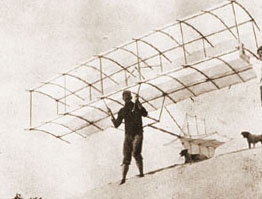Wright is Wrong!
 Augustus Herring on a glider similar to his powered design.
Augustus Herring on a glider similar to his powered design.
Powered, heavier-than-air flight has been heralded as the achievement of the Wright brothers. After years of study, research, sweat, and hard work, they documented their powered flight at Kitty Hawk North Carolina on December 17, 1903. "So what, everyone knows that!" is the common response to such a statement but it is just as likely that they were not the first to do so. It is documented that the first manned, powered, heavier-than-air flight was accomplished here in Michigan by Augustus Moore Herring more than four years before the famous Wright brothers.
Mr. Herring worked closely with a man who was an associate and promoter of the Wright brothers, Octave Alexandre Chanute. Chanute, assisted by Herring, produced and flew in several glider designs at Miller Beach and Dune Park in Indiana. Sand dunes, like those in Kitty Hawk and Indiana, were needed for the early experimental flights.
Herring flew 50 feet aboard a glider with a compressed air engine on Oct. 11, 1899, and took a 10-second flight 10 days later, flying a total of 73 feet. Although he used a compressed air engine with enough compressed air for a 15-second flight on something we might consider to be more like a powered hang glider, he was the first to build and pilot a powered, heavier-than-air, aircraft. The Wright brothers' flight was about the same in duration (12 seconds) but somewhat longer in distance (120 feet). Herring's second flight was witnessed by a reporter from 'The Benton Harbor Evening News' but no photographs were taken. For some reason, the report wasn't given any real consideration. It should be noted that earlier in June of 1897 Chanute and Herring jointly applied for and received a patent in Great Britain for a powered version of their tri-plane glider. Also to be noted is the fact that Chanute's 1902 gliding machine, test piloted by Herring, was stored along with the Wright 1902 Glider, in the loft of the Wrights' workshop.
It doesn't seem unreasonable to believe that Herring, whose work was closely related to the Wright brothers, would have beat them in the powered, heavier-than-air, flight race. Given the newspaper report and the earlier patent as well as other documentation and witnesses, it seems even probable that Herring's flight was first. However, try and find any mention of Herring in the history books and you'll likely come up with scant references. The Wright brothers have a National Monument (A 60-foot granite monument) on Kill Devil Hill, North Carolina. The First Flight Society, one of aviation's oldest organizations, has a yearly pilgrimage to the Monument on December 17th to commemorate and celebrate the Wright brother's first flight. The year 2003 was celebrated as the 100th anniversary of the first, heavier-than-air, powered flight.
I'm of the personal opinion that credit should go where credit is due. There should be a monument in St. Joseph Michigan (I'm not sure if there is one) and we should have celebrated the first flight centennial back in October of 1999. Herring should be our first flight hero and Michigan should be the state to lay claim to the place where it happened. At least we have the Wright Bicycle Shop at Greenfield Village in Dearborn.
Comment about this article on the
Epress Forum Board
.
|
|
Mystery Airship of 1897
 Poster of 19th Century Play A Parody of Airship Sightings
Poster of 19th Century Play A Parody of Airship Sightings
19th-century reports of mystery airship sightings may indicate U.S. cooperation in secret military test flights of powered rigid balloon designs. An airship arms race had developed between Germany and France long before WWI. Considering French aviation technology, the political tension between Germany and France, France's alliances with Britain, Canada, and the U.S.A., a theory regarding the mystery airship sightings can be formed. This theory is as follows . . .
From the fall of 1896 until the spring of 1897, as many as two different French-designed airships, manned by Canadian crews, were used in secret test flights across the continental United States from California to the Great Lakes and then to Canada. The flights were mostly at night with the trip beginning in October 1896 and ending in April 1897 (with a possible crash landing near Kalamazoo MI). France, Britain, and Canada use the U.S. for the test flight as a secret location away from Europe. The U.S. government may, or may not, have been informed of these secret test flights.
It is also possible that German general Ferdinand von Zeppelin was involved as a spy in the mystery airship flights. Zeppelin is said to have brought the rigid balloon design idea to Germany after returning from a trip to America. In 1899, Ferdinand Zeppelin was granted a factory complex to build "Zeppelins" by German Chancellor Wilhelm II. Zeppelin is considered the first to produce an airworthy, powered, ridged balloon design that used hydrogen gas for lift. Germany used the technology first for commercial uses and ultimately for military uses in WWI (15 years later).
Eyewitness Descriptions: A cigar-shaped balloon (pointed on its ends), covered with a canvas canopy, a hanging basket or carriage underneath, a wheel turbine or propeller, and a rudder for steering. Reports of the airship's size range anywhere from 30 feet to 300 feet long. It was said to have a red light at the front end, a green light at the rear, and possibly a white or yellow light on top. A high-intensity searchlight, presumably on the hanging carriage, was seen shining down and around for short periods. People were heard talking and some reports have two or three persons to as many as a couple of hundred people onboard. Also heard was a sound described as a whirring or humming sound of machinery or an "electric dynamo".
These descriptions are very similar to the French airship the "La France" and may be an improved version of that craft. Supporting Facts: The first "dirigible", designed by French aviation pioneer, Henri Giffard, was test flown in September 1852 and was powered by a 3 HP steam engine. In 1884, two French officers made a five-mile trip aboard the dirigible, La France, which was powered by an electric motor which was considered an improvement over using a steam engine for propulsion. It made seven flights between 1884 and 1885. This was only one year before the mystery airship sightings in America.
Description of the "La France": A long and slender car consisting of a silk-covered bamboo framework lined with canvas hung below the balloon. The car was 108 feet long (33 meters), 4.5 feet (1.4 meters) wide, and 6 feet (1.8 meters) deep and housed the lightweight batteries and the motor. The motor drove a four-bladed wooden tractor propeller that was 23 feet (7 meters) in diameter but that could be inclined upwards when landing to avoid damage to the blades. Renard also provided a rudder and elevator, a sliding weight to compensate for any shift in the center of gravity, and a heavy guide rope to assist in landing.
The first flight of La France took place on August 9, 1884. Renard and Krebs landed successfully at the parade ground where they had begun-a flight of only 5 miles (8 kilometers) and 23 minutes but one where they had been in control throughout. During 1884 and 1885, La France made seven flights. Although her batteries limited her flying range, she demonstrated that controlled flight was possible if the airship had a sufficiently powerful lightweight motor. Pictures show the balloon to be better than twice as long as the car that hung below it, so that would make the balloon longer than 200 feet.
The Political Climate: During the 1870-1871 war between France and Prussia, the military usefulness of balloons became apparent to the French late in 1870, when the Prussians besieged Paris. In 1904 France and Britain signed the Entente Cordiale (friendly understanding). The objective of the alliance was to encourage cooperation against the perceived threat of Germany.
Comment about this article on the
Epress Forum Board
.
|



